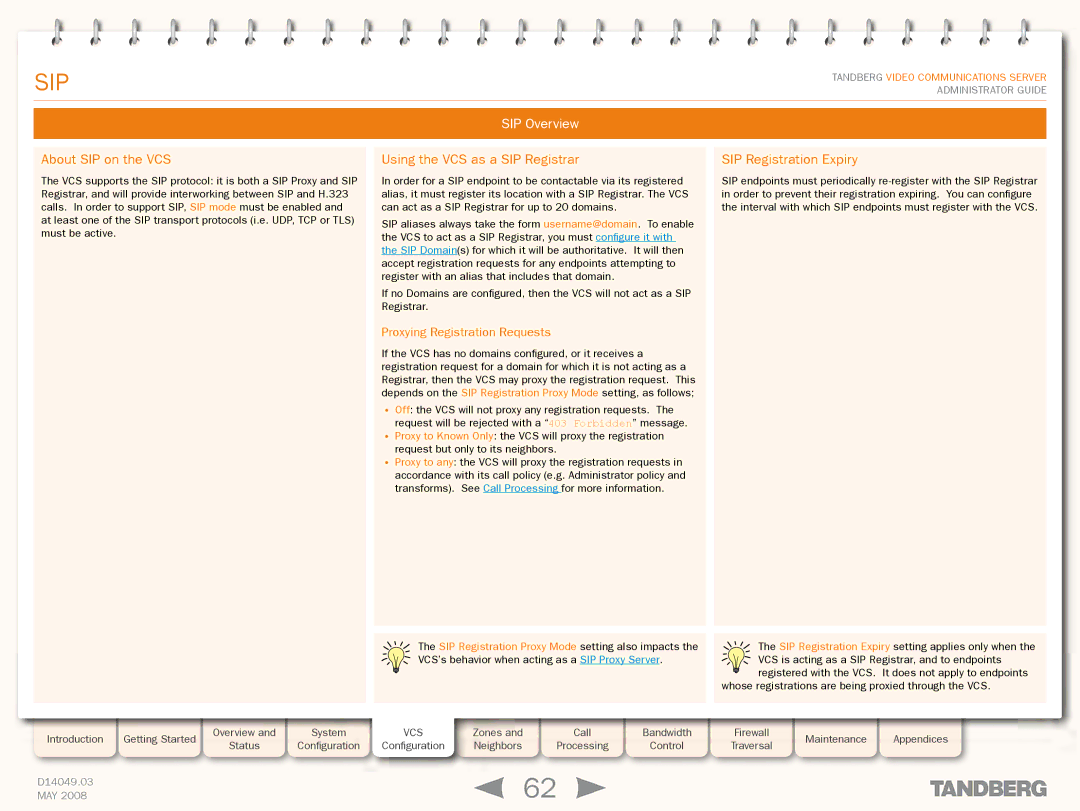
Grey Headline (continued)
SIP
TANDBERG VIDEO COMMUNICATIONS SERVER ADMINISTRATOR GUIDE
SIP Overview
About SIP on the VCS
The VCS supports the SIP protocol: it is both a SIP Proxy and SIP Registrar, and will provide interworking between SIP and H.323 calls. In order to support SIP, SIP mode must be enabled and at least one of the SIP transport protocols (i.e. UDP, TCP or TLS) must be active.
Using the VCS as a SIP Registrar
In order for a SIP endpoint to be contactable via its registered alias, it must register its location with a SIP Registrar. The VCS can act as a SIP Registrar for up to 20 domains.
SIP aliases always take the form username@domain. To enable the VCS to act as a SIP Registrar, you must configure it with the SIP Domain(s) for which it will be authoritative. It will then accept registration requests for any endpoints attempting to register with an alias that includes that domain.
If no Domains are configured, then the VCS will not act as a SIP Registrar.
Proxying Registration Requests
If the VCS has no domains configured, or it receives a registration request for a domain for which it is not acting as a Registrar, then the VCS may proxy the registration request. This depends on the SIP Registration Proxy Mode setting, as follows;
•Off: the VCS will not proxy any registration requests. The request will be rejected with a “403 Forbidden” message.
•Proxy to Known Only: the VCS will proxy the registration request but only to its neighbors.
•Proxy to any: the VCS will proxy the registration requests in accordance with its call policy (e.g. Administrator policy and transforms). See Call Processing for more information.
SIP Registration Expiry
SIP endpoints must periodically
|
|
|
|
|
|
| The SIP Registration Proxy Mode setting also impacts the |
|
| The SIP Registration Expiry setting applies only when the | ||||||||||
|
|
|
|
|
|
| VCS’s behavior when acting as a SIP Proxy Server. |
|
| VCS is acting as a SIP Registrar, and to endpoints | ||||||||||
|
|
|
|
|
|
|
|
|
|
|
|
|
|
| registered with the VCS. It does not apply to endpoints | |||||
|
|
|
|
|
|
|
|
|
|
|
|
|
| whose registrations are being proxied through the VCS. | ||||||
|
|
|
|
|
|
|
|
|
|
|
|
|
|
|
|
|
|
|
|
|
Introduction | Getting Started |
| Overview and |
| System |
| VCS | Zones and |
| Call |
| Bandwidth |
|
| Firewall |
| Maintenance |
| Appendices |
|
| Status |
| Configuration |
| Configuration | Neighbors |
| Processing |
| Control |
|
| Traversal |
|
|
| ||||
|
|
|
|
|
|
|
|
|
|
|
|
|
| |||||||
|
|
|
|
|
|
|
|
|
|
|
|
|
|
|
|
|
|
|
|
|
D14049.03 |
|
|
|
|
|
|
| 62 |
|
|
|
|
|
|
|
|
|
| ||
MAY 2008 |
|
|
|
|
|
|
|
|
|
|
|
|
|
|
|
|
| |||
